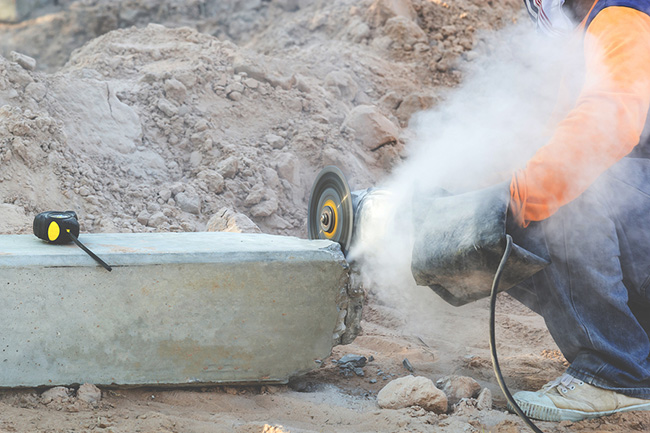Alarm over silica exposure among tunnel and construction workers

Silica dust is a serious issue for construction and tunnel workers. It’s crucial to know how to work safely with silica dust in the industry.
In fact, a black lung specialist has expressed alarm that at-risk Australian construction and tunnel workers may not be being tested for silicosis. Silicosis is an incurable and often deadly lung disease caused by breathing in crystalline silica.
What Experts Say
“Silica is actually a lung carcinogen. And it causes renal disease, it causes other auto-immune diseases like rheumatoid arthritis and other things, so silica exposure is a huge problem,” Dr Cohen told the ABC.
Speaking at a parliamentary enquiry into the re-emergence of black lung disease in Queensland mines, Dr Cohen, who is a professor at the University of Illinois Black Lung Centre of Excellence, expressed concern about silica.
“There should be industrial hygiene monitoring of the exposure levels,” he said, adding that in America, a new law mandates for silica surveillance.
For one thing, “We [the US] just lowered our exposure level to silica from 0.1 milligram per metre cubed to 50 micrograms, or 0.05 milligrams per metre cubed, because of the horrendous diseases that occur from silica,” Dr Cohen told the ABC.
However Dr Cohen, speaking with 4BC radio, said the enquiry heard that Australian workers may be being exposed to 0.6 milligrams – six times the Australian limit and 12 times the new American limit.
“[Those workers] should really be in a medical surveillance program getting regular chest x-rays and also getting lung function testing,” he said.
He also cited testimony from the enquiry that a large number of workers are exposed to up to six times the legal limit of silica. In spite of this, they are working in tunnels without proper ventilation or respiratory equipment.
Similarly, Dr Cohen said construction workers are high risk for silica exposure.
“These workers are digging foundations but they are also working with concrete: they’re drilling into concrete, they’re jack hammering concrete and they’re cutting it, and that dust that’s generated from those activities is high in silica,” he said.
Exposure and symptoms
Dr Cohen told 4BC that unless there is a massive intensive exposure to silica dust or silica flour, the greatest danger comes from prolonged exposure over a number of years.
“If it’s intense exposure maybe less than five years, but lesser exposures, 10 years.”
“People develop shortness of breath and cough and they develop an inability to exercise and do things as they used to,” he said. He also added that they can get lung cancer.
Minimising Risk:
As per the hierarchy of control, Dr Cohen said engineering controls are more effective than PPE at minimising silica exposure risk.
Therefore, “One of the most important things is engineering controls to keep the dust levels down… you want water sprays – water to keep that dust down. Ventilation, suction ventilation to suck up the dust.”
Conversely, he suggests “And if you can’t control it with those engineering controls, the workers have to be fitted with proper masks,” he said.
Appropriate PPE for silica exposure:
Indeed, ProChoice Safety Gear, Product Development Manager, Brad Rodgers explains what the proper masks are. When dealing with silica dust – if using a conventional respirator – then either a particulate respirator must be used (P1, P2 or P3 filtering respirator) or an air supplied respirator.
In this case, he cited Worksafe Queensland’s guide to managing workplace silica exposure.
To illustrate, “Respirator filters for particles are graded in terms of their performance in removing particles from air to be inhaled. P1 filters have the lowest performance, and P3 filters the highest,” the guide states.
Furthermore, in choosing the respirator with adequate performance, there are two parameters which have to be matched. Notably, these are the:
- required minimum protection factor (RMPF)
- class of respiratory protection.
RMPF = Observed Dust Concentration / Workplace Exposure Standard
Examples in determining the level of respiratory protection needed. (Source: Worksafe Queensland)
| Concentration of respirable crystalline silica mg/m3 | Workplace exposure standard mg/m3 | Required minimum protection factor | Typical Group |
| 0.8 | 0.1 | 8 | Group A |
| 2.1 | 0.1 | 21 | Group B |
| 6.8 | 0.1 | 68 | Group C |
| 14.0 | 0.1 | 140 | Group D |
Examples of the protection factors of respirators for silica dusts. (Source: Worksafe Queensland)
| Typical Protection Factor | Suitable respirator type for mechanically generated silica dusts | Typical group |
| Up to 10 | Any of P1, P2 or P3 filters with half face piece, replaceable or disposable filter. | A |
| Up to 50 |
P2 filter in full face piece; Powered Air Purifying Respirators (PAPR) with – P2 filter, any head covering; PAPR with P3 , any head covering; Also, half face piece respirator with positive pressure demand or continuous flow airline. |
B |
| Up to 100 |
P3 filter in full face piece, Full face piece air hose type. |
C |
| 100+ |
PAPR with P3 filter, head covering and blouse; Head covering airline respirator –continuous flow; Also, full face piece – continuous flow or +ve pressure demand air supply. |
D |
Lastly, “If the user cannot fit the mask correctly and ensure a suitable facial seal they run the risk of exposure to the airborne contaminant,” Rodgers said. Additionally, Rodgers explained that fit testing a respiratory protection mask is also critical, as per the Australian Standard AS/NZS1715:2009 .
Moreover, he said ProChoice Press to Check™ Cartridges have the unique and proprietary FIT CHECK system built into the design of the cartridge.
“This allows the user to easily conduct a quick ‘Negative Pressure’ Fit Check. This is a critical part of the user’s start up or pre-work check they must carry out to ensure they are protected adequately every working shift,” Rodgers said.








































































